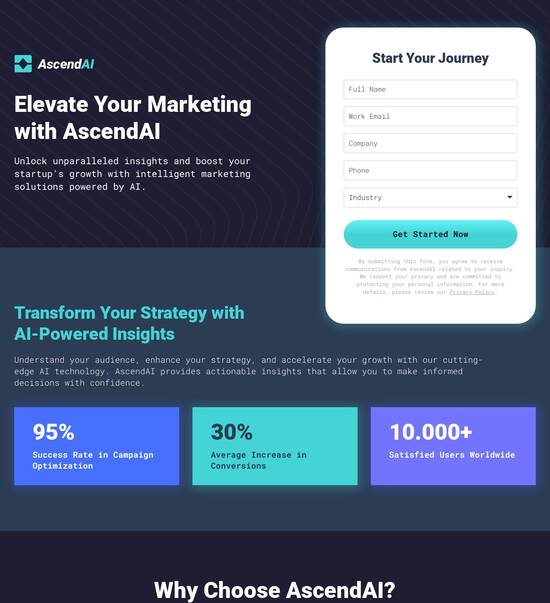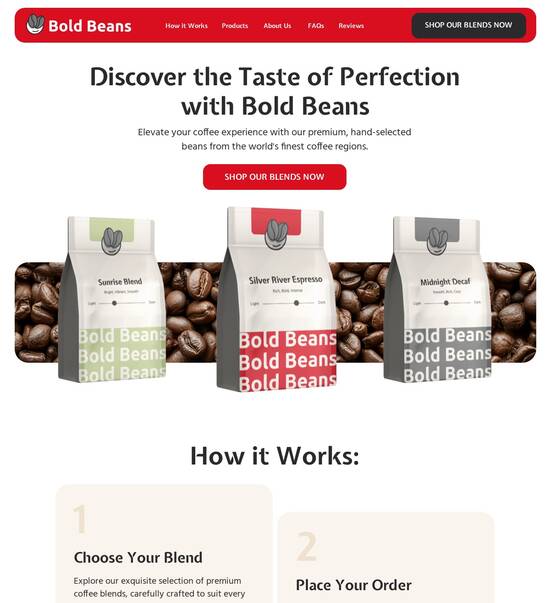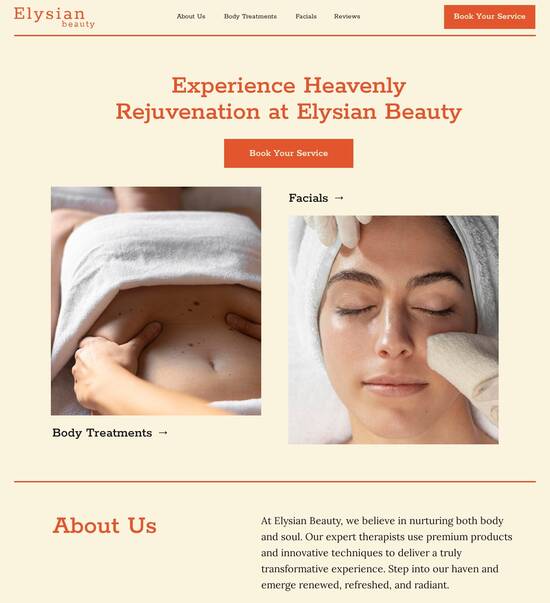
Landing page template for Medical assistants
Use TemplateAbout template
Attract clients and showcase your skills with style using our landing page templates for Medical assistants. Let's convert those visitors into clients!
Recommended templates

Easy to build without coding
With the intuitive drag-and-drop builder, anyone on your team can create high-converting pages without any knowledge of code or design. Make enhancements to your landing page with custom widgets using Javascript, HTML/CSS, or third-party scripts.

Multiple layouts for any industry and goal
Select from 500+ landing page layouts built to boost conversions across industry-specific scenarios. Customize them by adjusting fonts, adding images, and generating on-brand content with the AI assistant. Quickly scale with Instablocks® and Global Blocks that you can save, reuse, and update globally.

Loads fast and looks polished on any device
Every template is responsive, which means they present professionally on any device and load blazingly fast with our Thor Render Engine. You can also power them up with Google AMP technology to deliver an unparalleled mobile experience and drive higher conversions.

Robust analytics & experimentation
Get real-time updates and reporting across all your devices, showing the number of visitors, conversions, cost-per-visitor, and cost-per-lead. Launch AI-powered experiments, run A/B tests, and use heatmaps to analyze user behavior, then optimize your landing page to maximize conversions.







Easy to build without coding
With the intuitive drag-and-drop builder, anyone on your team can create high-converting pages without any knowledge of code or design. Make enhancements to your landing page with custom widgets using Javascript, HTML/CSS, or third-party scripts.
Multiple layouts for any industry and goal
Select from 500+ landing page layouts built to boost conversions across industry-specific scenarios. Customize them by adjusting fonts, adding images, and generating on-brand content with the AI assistant. Quickly scale with Instablocks® and Global Blocks that you can save, reuse, and update globally.
Loads fast and looks polished on any device
Every template is responsive, which means they present professionally on any device and load blazingly fast with our Thor Render Engine.
Robust analytics & experimentation
Get real-time updates and reporting across all your devices, showing the number of visitors, conversions, cost-per-visitor, and cost-per-lead. Launch AI-powered experiments, run A/B tests, and use heatmaps to analyze user behavior, then optimize your landing page to maximize conversions.
All the features you need to build lead-generating landing pages
Explore more featuresLearn how to build top-performing landing pages for any goal
FAQs
Leading the way in building high-performing landing pages





How to create an effective landing page template for medical assistants
Crafting a landing page template for medical assistants involves understanding the unique needs of this audience. Instapage offers powerful tools to create optimized and engaging landing pages that can attract potential clients and enhance your digital marketing strategies. Here's a step-by-step guide to creating a compelling landing page tailored for medical assistants.
Step 1: Choose a high-converting template
Selecting the right landing page template is crucial. Instapage provides over 100 pre-built templates, specifically designed to resonate with your target audience. Here’s why choosing the appropriate template is essential:
- Alignment with audience needs: The template should reflect the interests and pain points of medical assistants.
- Professional design: A visually appealing design conveys trust and professionalism.
- Mobile responsiveness: Ensure the template performs well on various devices to reach more potential clients.
Step 2: Optimize for conversions
Optimization is key to driving conversions. Use Instapage's built-in tools to enhance your landing page effectively.
- A/B testing: Experiment with different headlines and call-to-action buttons to find what drives the most engagement.
- Heatmaps: Analyze user behavior on the page to understand what grabs attention and where users drop off.
- Clear call-to-action: Make sure your CTA is prominent and compelling, encouraging visitors to take action.
Step 3: Personalize the experience
Personalization can significantly increase the effectiveness of your landing page. Utilize dynamic text replacement and tailored content to connect with medical assistants on a more personal level.
- Industry-specific language: Use terminology that resonates with medical professionals, enhancing relatability.
- Targeted messaging: Craft messages that directly address the specific needs of medical assistants, such as time management or patient interaction.
- Effective visuals: Incorporate relevant imagery that aligns with the medical field, reinforcing the context.
By following these steps, you will be well on your way to creating a highly effective landing page that serves medical assistants
Now, let’s explore some frequently asked questions that can further help you understand how to maximize the potential of your landing page template.
Landing page template for medical assistants
Understanding the importance of landing pages in healthcare marketing
Landing pages play a critical role in healthcare marketing, particularly for medical assistants who are often the first point of contact for patients. These pages are designed specifically to convert visitors into leads or patients, ensuring that healthcare facilities can capture important information and provide tailored services. A well-designed landing page not only captures attention but also fosters trust and encourages potential patients to engage further.
Medical assistants interact with a diverse target audience, including patients, healthcare providers, and other stakeholders. Understanding who these individuals are and what they seek can inform the design and functionality of the landing pages. By catering to specific demographics such as age, health concerns, or geographical location, medical assistants can create targeted content that resonates with their audience.
The role of landing pages for medical assistants
The primary purpose of landing pages is to convert visitors into leads or patients. For medical assistants, this translates to capturing patient information for appointment requests, inquiries, or accessing valuable resources. Effective landing pages have clear calls to action (CTA) that guide users toward objectives like signing up for newsletters, making appointments, or accessing telehealth services.
Identifying the target audience is crucial in this process. Typical patients engaging with medical assistants may vary widely, including families seeking routine check-ups, individuals looking for specialty care, or elderly patients requiring ongoing treatment. By understanding the needs and expectations of these groups, medical assistants can create landing pages that not only capture attention but also offer relevant and meaningful content.
Essential features of landing page templates for medical assistants
When creating landing pages for medical assistance, essential features must enhance user experience. One such feature is a tagging system, which allows for the easy organization and retrieval of content. Medical assistants can categorize content based on medical services offered, health advice, or patient stories, making it simple for users to find relevant information quickly.
Another vital addition is an HTML builder that provides a customizable framework for landing page design. With the capability to insert elements using HTML, medical assistants can enhance both the aesthetic appeal and functionality of the landing page. This flexibility allows for unique branding opportunities and can accommodate specific requirements that may align with medical practices.
Responsive layouts: adapting to user needs
In today's multi-device landscape, responsive layouts are paramount. Ensuring seamless performance across different web browsers is crucial for retaining visitor interest. Websites that load poorly or do not adapt display correctly on mobile devices risk losing potential patients. Medical assistants must prioritize responsive design to meet users where they are.
Another element focusing on optimization is the DOMContentLoaded event, which impacts load times. Optimizing loading times not only enhances user experience but also improves the overall ranking of the page on search engines. Techniques such as minimizing CSS files and deferring JavaScript can lead to faster load speeds, thus benefiting both the facility and its users.
Elements of effective design in landing pages
Designing landing pages with effective visual aesthetics is integral to engaging patients. Color psychology plays a significant role in this design process. Specific colors, such as blue and green, are known for evoking feelings of trust and tranquility, making them effective choices for healthcare-related content. Medical assistants can leverage these principles to create welcoming environments that instill confidence in visitors.
Font selection, too, significantly impacts readability and engagement. Choosing clear and professional fonts ensures that information is easily accessible to all visitors. This aspect is particularly essential in the medical field where users may include older adults or individuals with varying degrees of vision. When content is structured with precision, utilizing a clear header and comprehensive footer detailing contact information, navigation links, and legal disclaimers, landing pages become user-friendly.
Use clear, legible font styles.
Incorporate a consistent color scheme that reflects professionalism.
Ensure headers and footers serve functional purposes.
Utilizing columns for enhanced information flow
Multi-column layouts can significantly improve the flow of information, dividing content into digestible sections that enhance user experience. By breaking up text into accessible columns, medical assistants can present information in a structured format that encourages reading engagement. This layout option also fosters a clean and organized appearance, making it visually appealing.
Moreover, balancing content and images is crucial for maintaining visual harmony on landing pages. Utilizing high-quality images that relate to medical services or include human elements can create a more inviting atmosphere. Techniques for achieving this balance involve positioning images strategically alongside text and ensuring that neither element overwhelms the other, thus creating a more engaging experience for users.
Integration of modern technology in landing page design
Incorporating video and interactive elements into landing pages can significantly enhance patient engagement. Videos that explain procedures or provide insights into patient care can capture attention and keep viewers informed. These short clips offer a personal touch, making the medical facility seem more approachable. Medical assistants can curate visually appealing video content to align with their messaging and objectives.
Interactive features, such as quizzes or feedback forms, also facilitate greater interaction. They prompt visitors to engage meaningfully with the content, leading to higher chances of conversion. Not only do these interactive elements elevate the user experience, but they can also capture valuable data that informs future marketing efforts.
Addressing common problems in healthcare landing pages
Identifying common pitfalls is essential in creating effective landing pages. Design missteps can hinder lead conversion and affect patient trust. For instance, a cluttered layout or overwhelming information can discourage users from interacting. It is crucial to adopt a clean, straightforward design that guides visitors toward important actions.
Content issues also demand attention. Clear, engaging presentations of medical content are vital. Avoiding complex jargon and ensuring that information is relevant and accessible allows potential patients to feel empowered. By addressing these challenges, medical assistants can create pages that effectively convert visitors into leads.
Ensure a clean and straightforward design.
Avoid excessive medical jargon that can confuse visitors.
Provide clear call-to-action prompts throughout the page.
Tools for optimization and continuous improvement
Utilizing various tools for optimization is key to continuous improvement. Features like download panels allow users to access resources such as eBooks or brochures directly, enhancing the value of the landing page. These resources can aid in patient education or marketing efforts, making them a strong addition to any landing page.
Analytics serve a critical function in tracking performance. When assessing landing page effectiveness, medical assistants should focus on metrics such as conversion rates, user engagement, and bounce rates. Through these analytics, insights can inform adjustments and improvements, allowing the content to remain relevant and effective.
Designing for compliance and accessibility
Navigating healthcare regulations in digital marketing is crucial for maintaining compliance. One of the most important considerations is HIPAA compliance. Ensuring that patient information is securely handled on landing pages protects both patients and providers from potential legal repercussions. Medical assistants should be well-versed in these regulations and integrate security features into their designs.
Accessibility standards also play a significant role. Ensuring that landing pages are usable for patients with disabilities is not merely best practice but also a legal requirement. Implementing accessibility features, such as text-to-speech formats, alt text for images, and navigable designs, ensures that all visitors can interact effectively with the content.
Success stories: case studies of effective landing pages
Analyzing successful landing pages can provide valuable insights into effective practices. Case study 1 focuses on a high-performing landing page from a well-regarded medical assistant practice. This page successfully leverages targeted content, an engaging design, and streamlined conversion pathways that increased appointments by over 30% within three months.
In contrast, case study 2 illustrates a landing page that initially underperformed due to cluttered design and unclear messaging. After an iterative process that involved streamlining the layout and clarifying CTAs, this page saw a significant increase in engagement and conversion rates, demonstrating the importance of continual optimization.
Future trends in landing page development for medical assistants
As technology evolves, so too does the potential for landing page development. One promising trend is the use of artificial intelligence for optimization. AI can personalize landing page experiences based on user behavior and preferences, tailoring content to individual needs and thus enhancing conversion rates.
Another innovative direction is the integration of augmented reality (AR) features, which could transform patient engagement. For example, AR could allow prospective patients to visualize procedures or get interactive tours of the facility. Such advancements could make patient education more compelling and interactive.
Summary of key strategies for building effective landing pages
Recapping best practices can solidify understanding of effective landing page strategies. A critical aspect is the integration of visual and textual elements, ensuring a balanced mix that captures attention without overwhelming visitors. Striking this balance can lead to improved engagement and ultimately drive conversions.
Regular updates and testing of landing pages are also paramount for success. By keeping content relevant and in line with healthcare advancements, medical assistants can ensure that their pages are effective marketing tools that resonate with their audience.
Ready to skyrocket conversions?
Supercharge your ad campaigns with high-performing landing pages
Get started














